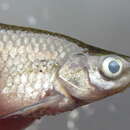Diagnostic Description
provided by Fishbase
Last unbranched ray of dorsal fin thorny, long and with posterior denticulation; barbels not well developed, anterior barbel very short, just reaching the posterior side of the maxilla, posterior barbel just reaching the middle of the eye (Ref. 27628). Dorsal side brown-silver colored, ventral side silver, with a darker band on the flanks; fins not colored (Ref. 27628).
Diseases and Parasites
provided by Fishbase
White spot Disease. Parasitic infestations (protozoa, worms, etc.)
Diseases and Parasites
provided by Fishbase
Eye Infection (Diplostomum sp.). Parasitic infestations (protozoa, worms, etc.)
Morphology
provided by Fishbase
Dorsal soft rays (total): 8; Analsoft rays: 6 - 7
Trophic Strategy
provided by Fishbase
Hardy, prefers quiet, well-vegetated waters in lakes, swamps, and marshes or marginal areas of larger rivers and slow-flowing streams. Frequency of occurrence in Caprivi: occasionally on rocky streams, in standing deep water; common in shallow swamps and flood plains (Ref. 37065). Feeds on a wide variety of small organisms including insects, small snails and crustaceans, algae, diatoms, and detritus. Is preyed upon by the sharptooth catfish, tigerfish, largemouth breams (Serranochromis species) and birds.
Biology
provided by Fishbase
Hardy, prefers quiet, well-vegetated waters in lakes, swamps, and marshes or marginal areas of larger rivers and slow-flowing streams (Ref. 7248). In shallow, inshore areas of Lake Victoria especially where bottom is sandy (Ref. 4903). Bottom feeder (Ref. 12526). Feeds on a wide variety of small organisms including insects, small snails and crustaceans, algae, diatoms, and detritus (Ref. 7248). Preyed upon by the sharptooth catfish, tigerfish, largemouth breams (Serranochromis species) and birds (Ref. 7248). Spawns in river and streams during rainy season in Lake Victoria basin (Ref. 4903). Spawns amongst vegetation during summer (Ref. 7248).
Importance
provided by Fishbase
fisheries: commercial
Straightfin barb
provided by wikipedia EN
- license
- cc-by-sa-3.0
- copyright
- Wikipedia authors and editors
Straightfin barb: Brief Summary
provided by wikipedia EN
The straightfin barb ('Enteromius paludinosus) is a species of ray-finned fish in the family Cyprinidae. E. pleurogramma is sometimes included here, but while it is certainly extremely closely related, it appears to be a distinct cryptic species.
The straightfin barb is found in Burundi, Kenya, Malawi, Tanzania, and Uganda.
Its natural habitats are rivers, freshwater lakes, freshwater marshes, and inland deltas.
It is not considered a threatened species by the IUCN.
- license
- cc-by-sa-3.0
- copyright
- Wikipedia authors and editors

